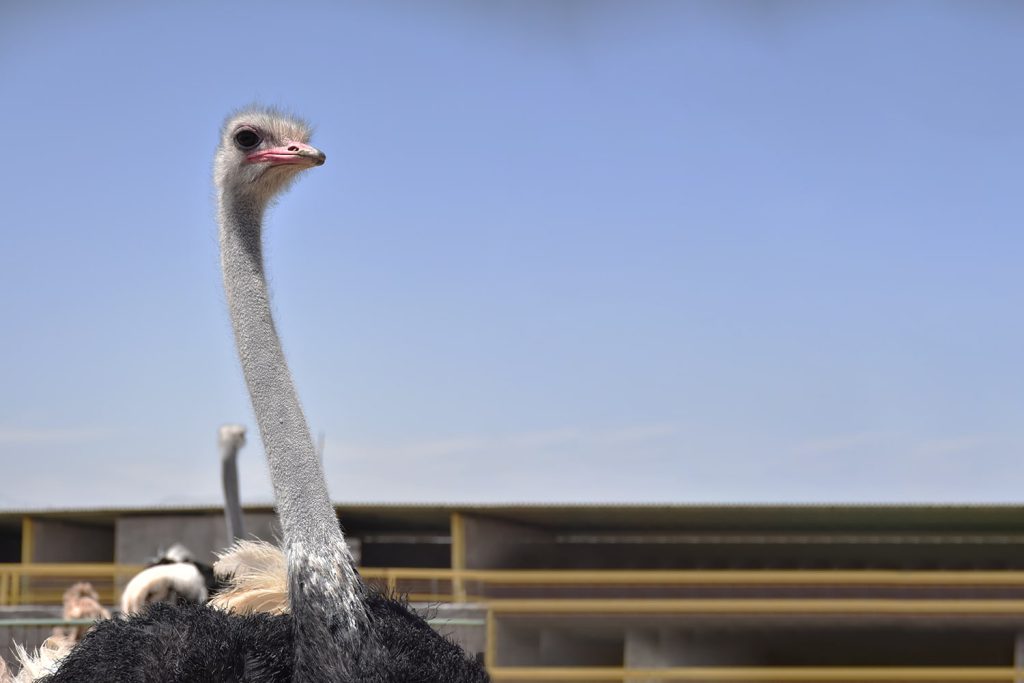Newcastle disease in ostrich

Newcastle disease is a highly contagious disease of birds caused by Paramyxovirus.
This viral disease occurs mostly among birds that are kept in groups and in one place. Birds affected by this disease include turkeys, geese, ducks, pheasants, quails, seagulls and other wild and captive birds, including ostriches and… Humans are not normally affected, but people in direct contact with infected birds may develop a short-term eye infection that clears up without treatment.
Ostriches, like other birds, have many diseases, but due to the high resistance of the body of these birds, the rate of disease involvement in them is significantly lower than other poultry. It is one of the most common diseases among all Newcastle poultry, and if the vaccine is injected at the right time, this disease can be prevented and the ostrich flock can be saved from group losses. Newcastle disease is highly contagious. All birds in a flock are usually infected within three to four days. The virus can be transmitted through contaminated equipment, shoes, clothing and free-flying birds. In the active respiratory phase, it can be transmitted through the air. The virus is not thought to travel very far this way. . Recovered birds are not considered carriers, and the virus usually does not live in the field for more than 30 days.
Newcastle Commune Period:
It varies from 2 to 15 days.
disease spread methods
– Wild and migratory birds such as pigeons, crows, sparrows, etc.
– Poultry or turkey farm infected with Newcastle disease near the ostrich habitat
– Contamination of water and food with Newcastle virus
– It is transmitted through the feces and secretions of infected birds from the nose, mouth and eyes
– Disease transmission by workers, tools and machines that are related to poultry farming
The virus can survive for several weeks in a warm, moist environment on feathers, manure, and other bird material.
– Transmission through polluted air and breathing of birds
– Eating with wild birds
– Failure to wash drinking troughs and feeders
Is it possible to transfer Newcastle disease from birds to humans?
If the egg or meat of an infected bird is used, or if he touches the carcass of a dead bird, or if he is present among sick flocks without wearing a mask or special clothes, there is a possibility of the disease spreading to humans.
But the human body is resistant to this virus and it can be treated by taking medicine and antibiotics. Red eyes, runny nose, dizziness and insomnia are among its symptoms.
signs
Observing birds carefully and observing them is the easiest way to understand their diseases.
Birds usually hide the symptoms of the disease in the first few days.
The symptoms of Newcastle disease are not much different from other respiratory diseases. The most common symptoms are: runny nose, excessive mucus in the trachea, cloudy air sacs, casts or plugs in the air passages of the lungs, and clouding of the cornea of the eye.
Changes in appetite, changes in the color and state of feces, lethargy and fatigue are the initial symptoms of any disease. Newcastle disease has unique symptoms that distinguish it from other diseases and help you diagnose:
• Loss of appetite
• Sneeze
• Depression
• Body lethargy
• Rapid breathing
• Cough
• Discharge from the nose
• Discharge from the eyes, wet eyes
• Green diarrhea
• Tilting of the head and neck
• Pulling the head back
• Uncontrollable movements of the neck such as twisting and bending
• Inability to hold the head
• Relaxation, muscle cramps and finally paralysis of the legs
• Convulsions and eventually death
• In laying birds, there may be a relative decrease in egg production.
Diagnosis
The acute form of the disease can be partially recognized from the clinical signs and autopsy. But the chronic form of the disease is confused with other respiratory diseases due to the similarity of its symptoms. Newcastle disease should be suspected when the respiratory symptoms are related to the lower part of the respiratory system (severe gasping for breath). The rate of spread of Newcastle disease is the best guide for its diagnosis.
Autopsy symptoms include swelling in the respiratory mucosa, inflammation and bleeding in the digestive tract mucosa, the presence of purulent and cheesy cysts in the tracheal mucosa, and exudative secretions at the beginning and along the trachea, especially the bifurcation of the trachea. This disease, like most viral diseases, has no drug treatment and the treatment is only supportive. Vaccination is done with two strains, B1 and Lasota.
If you or the veterinarian intend to perform an autopsy on the dead bird, you should pay attention to internal bleeding in the lungs, kidneys, trachea, larynx, ovaries and other organs of the bird, because Newcastle causes internal bleeding in these organs as well.
Necessary measures after identifying infected ostriches
Extreme heat can destroy Newcastle disease
After detecting any of the above symptoms in your birds, be sure to separate the affected cases and treat them in a separate environment, considering that Newcastle has a high rate of spread and contagion, it will require more care on your part. Therefore, always observe the physical and behavioral condition of the ostriches and quarantine suspicious cases immediately.
Treatment methods for ostriches affected by Newcastle disease
So far, no specific treatment has been found for this disease, but acute infections can be prevented to a large extent by visiting a veterinarian and using the necessary antibiotics. Ostriches with a strong immune system will recover after a few days of conflict, but the remaining neurological symptoms may cause changes and defects in your bird’s behavior and mood.
Newcastle pigeon disease can also spread through its carcass. To treat Newcastle pigeons, if the bird can still eat seeds, use tonic and protein supplements to strengthen. If he does not eat seeds, feed the animal with seeds such as mung bean, millet and wheat by hand and help the bird to strengthen to fight the virus.
How to prevent the occurrence of Newcastle disease in ostrich flocks?
The contact of ostriches with local and wild birds, sharing food with them and feeding on water and food contaminated with secretions and excreta of other birds causes Newcastle disease.
Due to the fact that ostriches are raised in open space and pastures, it is a bit difficult to separate them from wild birds, but by using nutritious food rich in vitamins and minerals, the body’s immune system can be improved to a large extent. It strengthened them and reduced the incidence of the disease.
It is better to raise ostrich chicks in a closed and controlled space until the age of two to three months and then transfer them to pastures and open space for grazing. In the meantime, you can apply for vaccination. The first vaccine will be at the age of two weeks and in the form of eye drops.The second vaccine at the age of one month will be a subcutaneous injection in the area under the throat or under the wing of the ostrich chick.
One of the best and most reliable ways to prevent Newcastle disease is bird vaccination. This method is done in three ways. Giving drops to the birds, spraying in the environment where the birds are, and the drinking method that mixes the solution in water with a temperature of 6 to 15 degrees and pours it into the bird’s drinkers to vaccinate all of them against illness.
Always clean the ostriches’ bedding, for this purpose use sawdust or soft cloths and change the bedding every few days, too much waste left on the bedding is the cause of many other diseases.
Wash the drinking and feeding containers well before each feeding.
And if you see the slightest contamination in their food and water container, change the ration. Consider private places to water and feed ostriches where other birds do not have access.
Timely identification of lethargic birds and their quarantine can also largely prevent the entire flock from being affected, but it is not enough to prevent the full spread of the virus.
Yukasel is a muscular, nervous and skeletal disease of ostriches that affects chickens less than 9 months old. If Newcastle ostrich occurs in 3-4 months old chickens, it has about 80% or more losses and if it occurs in adults, the flock must be killed quickly.
Prevention and treatment
Lasota vaccine can be considered one of the most famous examples of ostrich vaccines. This type of vaccine is suitable for Newcastle disease. Usually, the age of using this vaccine is 10 to 14 days, which is used as eye drops
At the age of 3 to 4 weeks, this vaccine can be used subcutaneously in the neck of the ostrich with a dose of 1 cc.
treatment:
1. Combine AVINEW vaccine with 100 cc of distilled water and pour one drop into the bird’s eye
2. Selenium and ad3 dissolved in water for one week
3. Injection of MERIAL vaccine after one week
